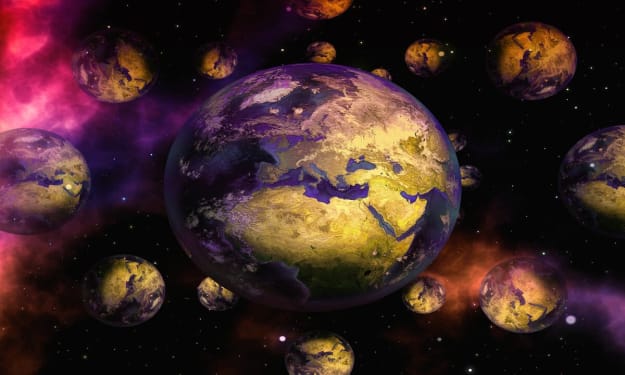Mysterious Object In Space
What Could It Be?

Space has always been a fascinating topic and continues to intrigue people even today. With the advancement of technology, space exploration has become more sophisticated, and scientists continue to discover new things. In recent years, the exploration of space has shifted from the study of individual planets to the study of entire star systems, with the focus being on understanding the conditions necessary to harbor life. One of the most intriguing discoveries in recent times is the concept of exoplanets, which are planets that exist outside our solar system. These planets are particularly interesting because they are located in zones where the conditions are right for the existence of life. The search for exoplanets has led to the discovery of thousands of planets orbiting other stars, giving scientists more insight into the possibilities of life existing beyond our solar system.
Another fascinating phenomenon that has been discovered in the universe is the existence of black holes. These are regions in space where the gravitational pull is so strong that nothing, not even light, can escape. These black holes are formed from the remnants of a massive star, which collapses in on itself, creating a huge gravitational field. Additionally, scientists have also discovered strange cosmic events, such as supernovas and gamma-ray bursts. These are incredibly intense explosions that can unleash energy equal to that of trillions of nuclear bombs within seconds. These events are rare and have been observed from afar, but they provide critical insights into how certain phenomena occur in the universe.
Overall, the exploration of the universe has much to offer, and scientists continue to unravel its mysteries. With continued advancements in technology and exploration, we may just uncover more about the universe and its vast wonders.
The universe is vast and as many scientists say, has no end. This is why they have continued exploring its marvels and observing everything around it. These explorations, led by scientists and astronomers of various research teams worldwide, have brought about the discoveries of dwarf planets, black holes, and a lot of strange phenomena. Even our galaxy, the Milky Way, which serves as the home to planet Earth, holds many mysteries yet to be seen and some just being discovered.
00:30 One such discovery is a huge object that was detected as it travelled through the Orion Nebula. What could this object be, how large is said object, and what purpose does it serve? Join us as we explore how this NASA probe accidentally detected something huge travelling through the Orion Nebula.
The Orion Nebula, also known as M42, is a nebula found in our home galaxy, the Milky Way. This nebula has been so notable that even ancient cultures have talked about it. 00:58 or used it as a timeless piece throughout history. M42 is so clear it can be seen without the aid of a telescope.
Not too long ago astronomers discovered an amusing object while they were going through some photographs of the Orion Nebula. These photographs had been taken earlier as they were looking through the solar system across the Orion Nebula with the aid of a telescope. When the images were reviewed they noticed a large object shaped like a cigar that had never been seen before.
01:25 This left them confused as it was not their first time exploring space and searching the night skies for nebulas. The astronomers then forwarded the image of this strange object to an extensive online database that gathers photographs and information regarding strange crafts witnessed all over the world. Unsurprisingly, this wasn't the first time amateur astronomers had sighted such objects. As they recorded each sighting, they talked about their encounters with this object, especially noting the extraordinary length of the object.
01:53 and how it does not match anything around the area where it was seen.
Several assumptions asking if this cigar-shaped object could be a comet or a problem with the camera used to take the image were brought forward. The astronomers who noticed this long object quickly debunked this, saying that neither space debris nor comets have shown up like this in all their years of astrophotography. But if this long object is not space debris or camera anomaly, what could it be? 02:23 be scattered all over the Milky Way galaxy, particularly in Orion's belt. The same time, others are saying that there might be other objects like this, located at different places in our galaxy. Another group of scientists and astronomers came up with the idea that it could be a probe coming from a distant galaxy sent to ours. However, the truth is we still don't know what this object is. All we know of this long object is that it has several unique features, but none resembles that of an asteroid.
02:53 any form of space debris. If the assumption that the object could be a probe sent from another planet, just like the way we send probes from Earth to study space and other planets is true, then it means that we are being observed by a piece of advanced technology, probably made by a civilization living far from ours, an idea that has kept some researchers driven to the edge of their seats in excitement. We have thousands of planets in our galaxy, so treating objects like 03:21 is what we should do, especially when these objects do not correspond with familiar objects seen in space.
Besides strange objects discovered in space, mysterious sounds can also be heard. Recently a NASA probe that has orbited the solar system and is now travelling beyond it detected a mysterious plasma hum as it progressed into interstellar space. This discovery was made by the iconic Voyager 1, the spacecraft that has spent over four decades in the solar 03:51 billion miles away from Earth. The Voyager 1 spacecraft has completed many missions in space, as it was the spacecraft that discovered lightning strikes in Jupiter's atmosphere and studied how the solar wind became smaller in the outer solar system. Voyager 1 has drifted away from the sun since 2012, and as the spacecraft continues to do this, it measures the plasma around it. Since 2012, scientists have transformed the Voyager 1's tools and sent it to an entirely 04:21 yet to be explored. This tool transformation occurred when Voyager 1 crossed the heliopause into the heliosphere. The heliopause is a region in space where the solar wind in that environment does not have enough power to hold the interstellar medium that orbits our galactic neighborhood back. The region is mostly quiet and can be compared to a monotone environment because of its narrow frequency bandwidth.
04:50 said in a statement about the mysterious hum, where detecting the faint persistent hum of interstellar gas. Every few years the solar wind in this heliopause region pushes back causing Voyager 1 to pick up these happenings as shockwaves. Even at this rate the impressive Voyager 1 probe detects this plasma hum. It has given scientists the belief that there is a much lower level of activity in interstellar space than initially thought.
05:16 A senior author and an astronomer at Cornell, James Cords, commented on the strange hum, saying that a solar outburst is like detecting a lightning burst in a thunderstorm before it calms. At some point, scientists had the idea that it was only through these shocks that Voyager 1 could measure the plasma density out in interstellar space. But now that scientists have heard this hum, they can use it to track the interstellar medium between shocks, which would help them understand much more about the large region of space that no one has explored.
05:46 Shammi Chatterjee, a Cornell astronomer, said, Now we know we don't need a fortuitous event related to the sun to measure interstellar plasma. Regardless of what the sun is doing, Voyager is sending back details. The spacecraft sends detail like a soldier on the field sends info back to his commander, giving a report of its location and what it feels around it. The craft is saying, here's the density I'm swimming through right now, and here it is now at another location.
06:15 Voyagers at a distance far from us will be doing this continuously. The twin spacecraft, Voyager 1 and Voyager 2, are programmed to keep exploring space as they would sail away from time immemorial into light years and stars. But scientists here on Earth feel that the spacecraft's days are numbered. They place the time space to be a decade, saying that the plutonium power sources would finally run dry. But until that happens, scientists are still getting benefits from every bit of data sent 06:43 these incredible inventions. And to be honest, I think these spacecraft are now like a form of engineering gift to science and researchers as they keep on giving.
Talking about more discoveries, Voyager 1 was the same spacecraft to detect active volcanoes as they spewed ash and gas up onto the surface of Io, a moon of Jupiter. This discovery made scientists believe Jupiter's moons were blazing with internal heat.
07:08 It is more active with volcanism than any other planet in the solar system explored by the spacecraft. These volcanoes of Io are not only explosive in nature, but they are extensive all over the planet. Theories propose that this could be the reason why Io's surface is found to be so smooth, as the forces of volcanism are giving it regular volcanic bathing. The planet's sighting represented the first time volcanoes have been looked at as they erupted at another location other than Earth.
07:36 The detection of several volcanic clouds by the probe showed that volcanism was widespread not just on Earth but on other planets as well. The photos of Io captured by Voyager showed volcanic plumes to be all over the place. Looking closely at the images, you will notice three plumes lined up in a single close-up picture frame. More photos were released a few days after the discovery on this planet was announced. They showed a young volcanic mountain with a weirdly shaped 30-mile-wide crater.
08:05 and dark lava flows stretching over a 60-mile distance. Other photos showed no meteorite impact craters visible on the slopes, providing strong evidence that the planet's surface was still relatively young. Scientists at the time could not fathom how the volcanoes still had the power to discharge volcanic material, although it has been shown that they've been active for centuries. And further research indicated that these volcanoes had more molten materials when compared to Earth's.
08:32 In the first photo examined during the announcement of the discovery, Dr. Smith said that cloud of gas and particulate matter rose as high as 180 miles above the surface, and materials produced from the eruption could be seen as they travelled at a speed similar to a bullet fired from a high-end machine gun. At this speed, a large amount of gas and ash will likely escape Io's gravity and go into space, but some of the ash probably falls back on the planet's surface.
09:00 with the flowing stream of lava that comes from such eruptions. These two materials are what scientists believed were the factors responsible for the satellite's young surface. A volcanic discovery also explained the coloring of Io, which has a yellow and deep red color, with some other areas appearing white. These colors showed that the planet's surface is steamed and fumed out from volcanic material, and possibly other degradation processes could also be held responsible. Some other processes responsible for the planet's young surface 09:30 could be the high-energy particles raining down from Jupiter's immense radiation belts and the electrodynamic interaction between Io and the planet's magnetic field. These factors can be responsible for creating strong electric fields which are believed to be powerful enough to distribute materials along Io's surface.
In conclusion, the exploration of our galaxy and the universe has led to many discoveries that continue to fascinate scientists and astronomers. Whether it's a large object travelling through the Orion Nebula, a mysterious plasma hum detected by Voyager 1, or the volcanic activity on Io, we continue to uncover new information that pushes the boundaries of our understanding of the cosmos. These discoveries highlight the importance of continued exploration and observation, as we strive to uncover the mysteries of the universe.
About the Creator
Corey Turner
Reading really is fundamental






Comments
There are no comments for this story
Be the first to respond and start the conversation.